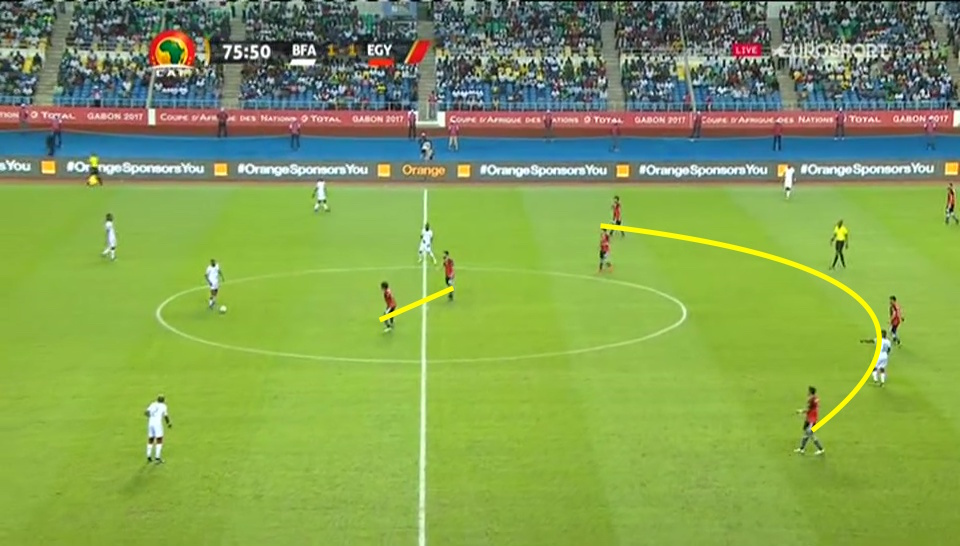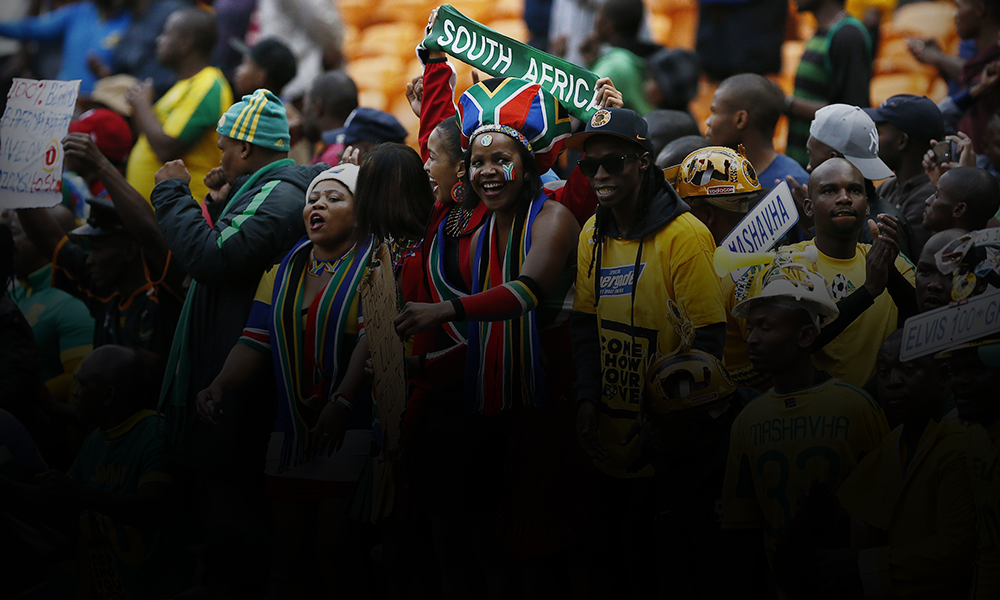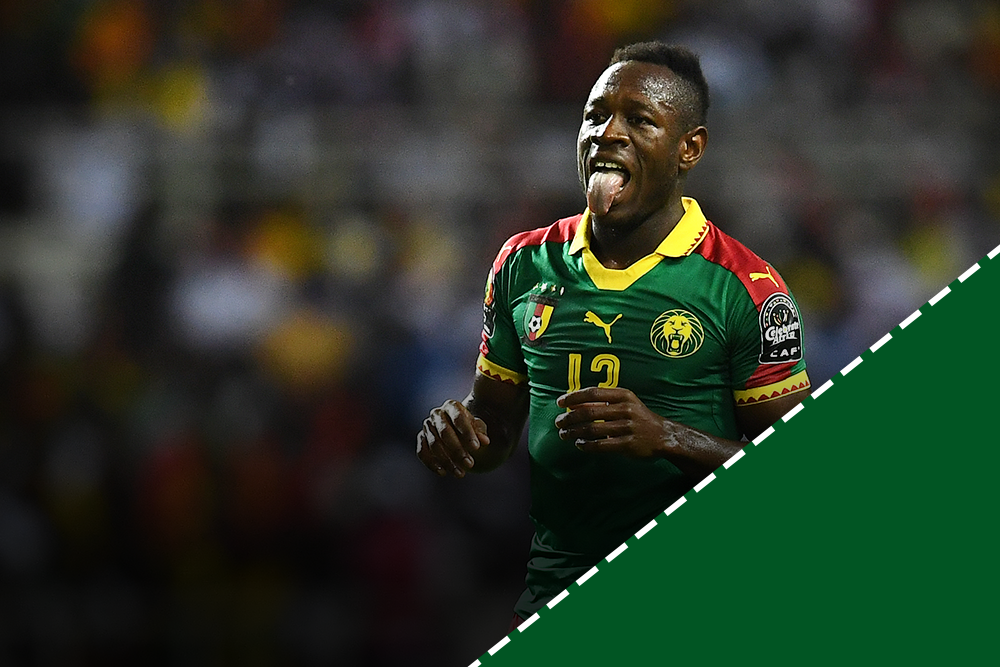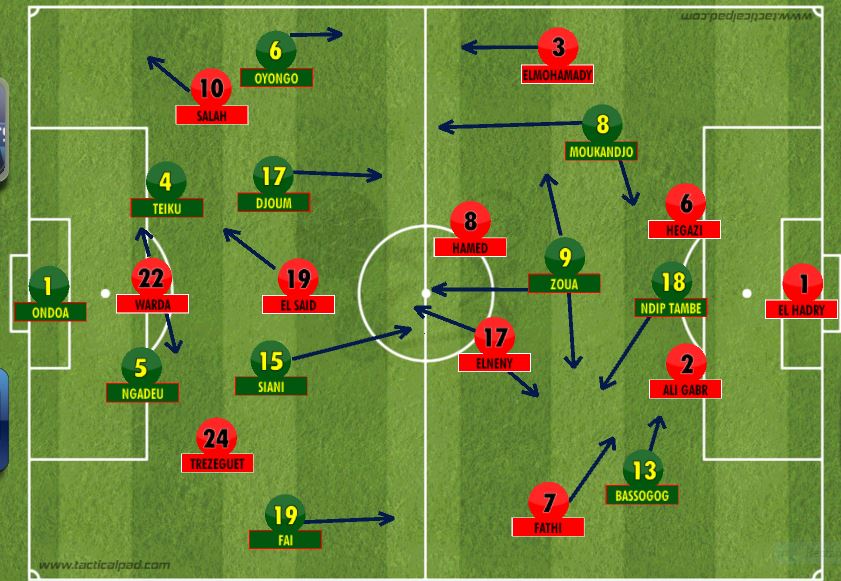Eric Devin writes a detailed tactical analysis about the AFCON semi-final that ended Burkina Faso 1-1 Egypt (3-4 Pens)
Burkina Faso (4-3-3): Hervé Kouakou; Steeve Yago, Issoufou Dayo, Bakary Koné, Yacouba Coulibaly; Charles Kaboré, Blati Touré, Abdou Razack Traoré (Banou Diawara 80′); Bertrand Traoré, Aristide Bancé (Alain Traoré 103′), Préjuce Nakoulma
Egypt (4-2-3-1): Essam El Hadary; Ahmed El Mohamady (Omar Gaber 107′); Ahmed Hegazy, Ali Gabr, Ahmed Fathy; Tarek Hamed, Ibrahim Salah; Mohamed Salah, Abdallah Said, Trézéguet (Ramadan Sobhi 85′); Mahmoud Kahraba (Amr Wada 74′)
Tournament football can be a strange animal; with only one winner, teams are much more willing to play negative football to reach their desired outcome. This is especially so in the knockout stages, but sometimes the identity of teams which take these roles can be surprising. Wednesday’s Africa Cup of Nations semi-final between Burkina Faso and Egypt was one such example.
Egypt, with Mohamed Salah and Ahmed El Mohamady, boast more household names than their opponents, who entered with a squad comprised largely of youngsters (Bertrand Traoré, the superb ‘keeper Hervé Kouakou) and journeymen (Charles Kaboré, Bakary Koné). However, true to the style that they had played against more illustrious opponents (Mali, Ghana, Morocco) at earlier stages, Egypt endeavored, despite their advantage in talent, to play an industrious style with a heavy emphasis on defending deep in their own half.
Always a prerogative of Cuper’s, this was reflected before the match’s start by the decision to use the veteran Ahmed Fathy at left back in place of the youngster Karim Hafez. Hafez is an exciting, and effervescent modern fullback, and his directness in support of Trézéguet was key in allowing Egypt to break down Morocco in the quarterfinals. El Mohamady was also more direct in that match, but Egypt were also caught on the counter several times by Morocco. It was only the narrow positions of Morocco’s wingers (and a lack of patience in their build-up play) that failed to see them take control of that match. Despite advancing, Egypt were somewhat cowed, resulting in a doubling down on the defensive side of their play, with Mohamed Salah often dropping deep to provide an extra man in midfield.
Burkina Faso, by contrast, had eased past Tunisia by playing an energetic match. Their 4-3-3 privileges the Chelsea youngster Bertrand Traoré; against the Eagles of Carthage, he was given essentially a free role with Préjuce Nakoulma played as a false nine and Cyrille Bayala cutting in from the wing. The midfield trio, particularly Abdou Traoré and Blati Touré, got forward in support as well, with Charles Kaboré protecting the back four. Against Egypt, however, Paulo Duarté played a more orthodox 4-2-3-1, with a big target man, Aristide Bancé used centrally, ostensibly to offer a more suitable target for the crosses of Bertrand Traoré.
Here, we see Egypt’s early set-up; even though the system Cuper employs is nominally a 4-2-3-1, the lack of a orthodox target man saw it manifest as more of a 4-2-4. Hamed and Ibrahim Salah would sit deep to deal ball with balls over the top to Bancé, whilst the attacking players would sit off of Burkina Faso’s back four. They also, as the image shows, played very narrowly, hoping to limit the supply to the two deepest midfielders, Kaboré and Touré and daring the Burkinabé fullbacks, Yago and Coulibaly, to get forward.
That narrowness extended further back, as the second image shows. Blati Touré has the ball at his feet, but faces little pressure from midfield, having gotten between Egypt’s two lines. Ibrahim Salah has moved wide to deal with the threat of Bertrand Traoré (just behind him), while Hamed looks to track the youngster’s potential runs (white arrows). On the flank, Yago has come forward, making himself an option on the right (yellow arrow), while on the near side, Nakoulma is in acres of space. Thus, despite Egypt having a reputation for being solid defensively, there was actually quite a bit of space to be exploited, particularly in wide areas, but Burkina Faso, as we shall see, struggled to take advantage of it.
Burkina Faso’s own opening defensive gambit, then, was to counter by making their 4-3-3 more of 4-5-1, with the first image showing a more expansive version of that. Bancé would stay forward to be an outlet for long balls, but the wide players, Bertrand Traoré and Nakoulma, would drop deep. In the second image, we can see how the defensive work rate of the wingers allows the back four (white line) to stay relatively compact to better cope with the positional fluidity of Egypt’s attacking players. The three central midfielders also benefit (white triangle), as they can play close to each other, as shown here, to limit the support that the front four get from the holding midfielders.
Again, the second image shows this in practice. Hamed has tried to advance with the ball, and the attackers ahead of him have demonstrated their ability to change roles, with Mohamed Salah taking up a central role and Kahraba has moved to a wide position. However, despite moving wide himself, Hamed is well-marshalled by Nakoulma, while Burkina Faso’s midfield three mark Salah and Said out of the game by staying compact. Trézéguet is in space on the opposite flank, but Egypt were loath to try to pick out the youngster, despite Steeve Yago lacking a high degree of positional discipline. Much as Bertrand Traoré functions as the focus of attack for Burkina Faso, so too does Salah for Egypt, and that led to both sides displaying an imbalance in attack, playing down the right hand side even as there were pockets of space on the left.
Here, we see Egypt sitting deeper, even after seven minutes into the match. At this point, Burkina Faso were essentially playing a 4-2-3-1, with Blati Touré forward in support of the attack and Nakoulma and Bertrand Traoré positioned very wide. Egypt again display a very compact shape, with the midfield protecting space and ten men behind the ball in the aforementioned 4-2-4. With a lack of immediate pressure from Said or Kahraba, Kaboré (with the ball) has plenty to aim at in terms of the wide players, and they were thus eager to cut inside to have a shot at goal. It was, however, this propensity to shoot from distance, or tight angles against a massed Egyptian back line that proved the Burkinabés’ undoing.
Here, in an image from later in the first half, Nakoulma is in acres of space (white circle) as El Mohamady, Egypt’s right back, has stayed very narrow. He receives the ball from the advanced midfielder, Touré, as Hamed, the right-sided defensive midfielder for Egypt tracks his opposite number’s run. Centrally, Bancé has space to run into (white arrows), splitting the defense, as Hegazy hustles to get back into position. Thus, despite Bancé being nominally marked, a cross (yellow arrow) seems the best option, as Egypt are caught out, if only slightly.
However, as the second image shows, Nakoulma opts instead to dribble at El Mohamady before releasing a wild shot. This not only allowed Hamed to safely double him, but also for Egypt’s entire back line to re-set themselves. Fathy, without Bertrand Traoré to worry about, has also moved centrally to mark Bancé, meaning the big striker’s advantage is all but gone. In the course of the match, Nakoulma was more of the guilty party in this regard, but Bertrand Traoré had his fair share of selfish moments as well, even when finding an overlapping fullback was also an option.
Here, we see the young fullback Coulibaly getting forward (white arrow), and, as his teammates did, he finds acres of space, Egypt preferring to clog the middle of the pitch, even as, seeking to provide more protection for Hamed and Ibrahim Salah, their formation more closely resembles a 4-4-1-1 at this point. Kahraba and Trézéguet are dropping deep, but they have also tucked inside meaning that Egypt’s shape remains narrow overall. Nakoulma has moved inside, meaning that Coulibaly is almost entirely on his own on the flank. Bertrand Traoré has the ball at his feet, and it seems the sensible option to switch play to Coulibaly, but, as the second image shows, he instead lines up a shot. Given the distance and the pressure he is under, to say the effort is ambitious is an understatement, but much like Nakoulma, the young winger has taken on too much, wasting a good opportunity.
Egypt eventually took the lead from a cracking long-range effort from Mohamed Salah, but Burkina Faso responded, unsurprisingly given the opportunities he had, through Bancé scoring from a cross. The big striker’s shot came with just under twenty minutes left, and both teams failed to press for a winner, perhaps afraid of being caught on the counter. In the first image, Burkina Faso are in the same 4-5-1 that they showed earlier in the match, but Bancé has dropped into midfield, leaving the pacy Nakoulma as the outlet for a counterattack.
Sitting just as deep as Egypt had, Burkina Faso, reacting to the introduction of the pacy Amr Warda for Kharaba, sought to pack midfield to limit the youngster’s opportunities. However, they also erred by retaining this shape after Bancé was subbed off in the first half of extra time. The striker’s effectiveness comes from his ability to be a target for long balls even under pressure from a deep-lying Egyptian defense. Here, his replacement, Alain Traoré challenges for a ball over the top, unsuccessfully. This is no surprise, as the former Lorient man is probably 5′ 9″ on a good day, but it also speaks as to how Burkina Faso failed to adapt their strategy; rather than balls over the top, they should have realized that a more patient approach was necessary, particularly without a suitable target.
Egypt, though, were frustratingly unambitious themselves. Despite the introductions of Warda and Sobhi, they continued to play the same deep-lying 4-4-2, although perhaps with a bit more width, as the first image shows. Burkina Faso were still able to build play through long balls, but their own uninspired play saw them waste too much possession through impatient passing or a lack of vision. In extra time (second image), Egypt sat even deeper, but Burkina Faso failed to press the issue. It was a fairly frustrating end to what had been an intriguing match, but also spoke to the idea of missed opportunity, which was certainly a leitmotif throughout. Both teams’ hesitancy in attack may have been a sign of respect for the opposition, but given the paucity of chances either side had, there was no strong likelihood of a rebuttal should one or the other have gone ahead. Egypt deserve full credit for limiting the dangerous play of Bertrand Traoré and Nakoulma, but the pair were equally to blame for their selfishness, offering a vexing end to what had been an impressive tournament for Burkina Faso.
Read all our tactical analyses here




































































